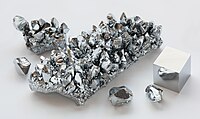
Photo from wikipedia
Monitoring the chlorophyll content changes in the plant via remote sensing is of great significance for understanding plant growth and monitoring vegetation pests and diseases, which is an important method… Click to show full abstract
Monitoring the chlorophyll content changes in the plant via remote sensing is of great significance for understanding plant growth and monitoring vegetation pests and diseases, which is an important method to study the global climate change. However, the monitored information is often interfered by leaf specular reflection, resulting in reduced accuracy of chlorophyll content inversion. In this article, to eliminate the interference of specular reflection in vegetation remote sensing, a polarized multispectral imaging system (PMSIS) used in the different-light-level situation to observe vegetation was developed, and a new specular reflection removal vegetation index (NSRVI) was proposed to better detect the vegetation health condition under specular reflection interference. Based on previous studies, several vegetation indices (simple ratio (SR) index, normalized difference vegetation index (NDVI); modified simple ratio index (mSR), modified normalized difference vegetation index (mNDVI); polarization based simple ratio index (pSR), polarization based normalized difference vegetation index (pNDVI); and NSRVI) were established, and the impact of specular reflection on vegetation health detection was evaluated. Correlation analysis was done on relative chlorophyll content [soil and plant analyzer development (SPAD)], SR, NDVI, mSR, mNDVI, pSR, pNDVI, and NSRVI to understand their potential ability to eliminate specular interference. The results show that SR and NDVI have the highest sensitivity to specular reflection, and the other three methods can alleviate the adverse effects of specular reflection to varying degrees. It was observed that NSRVI was well-correlated with SPAD (coefficient of determination ( $R^{2}) =0.899$ and root-mean-square error (RMSE) $=6.16$ ), highlighting the potential of NSRVI in eliminating specular reflection interference and identifying vegetation health condition. In summary, this method can effectively eliminate specular interference and improve the detection accuracy of vegetation health condition.
Journal Title: IEEE Transactions on Geoscience and Remote Sensing
Year Published: 2022
Link to full text (if available)
Share on Social Media: Sign Up to like & get
recommendations!